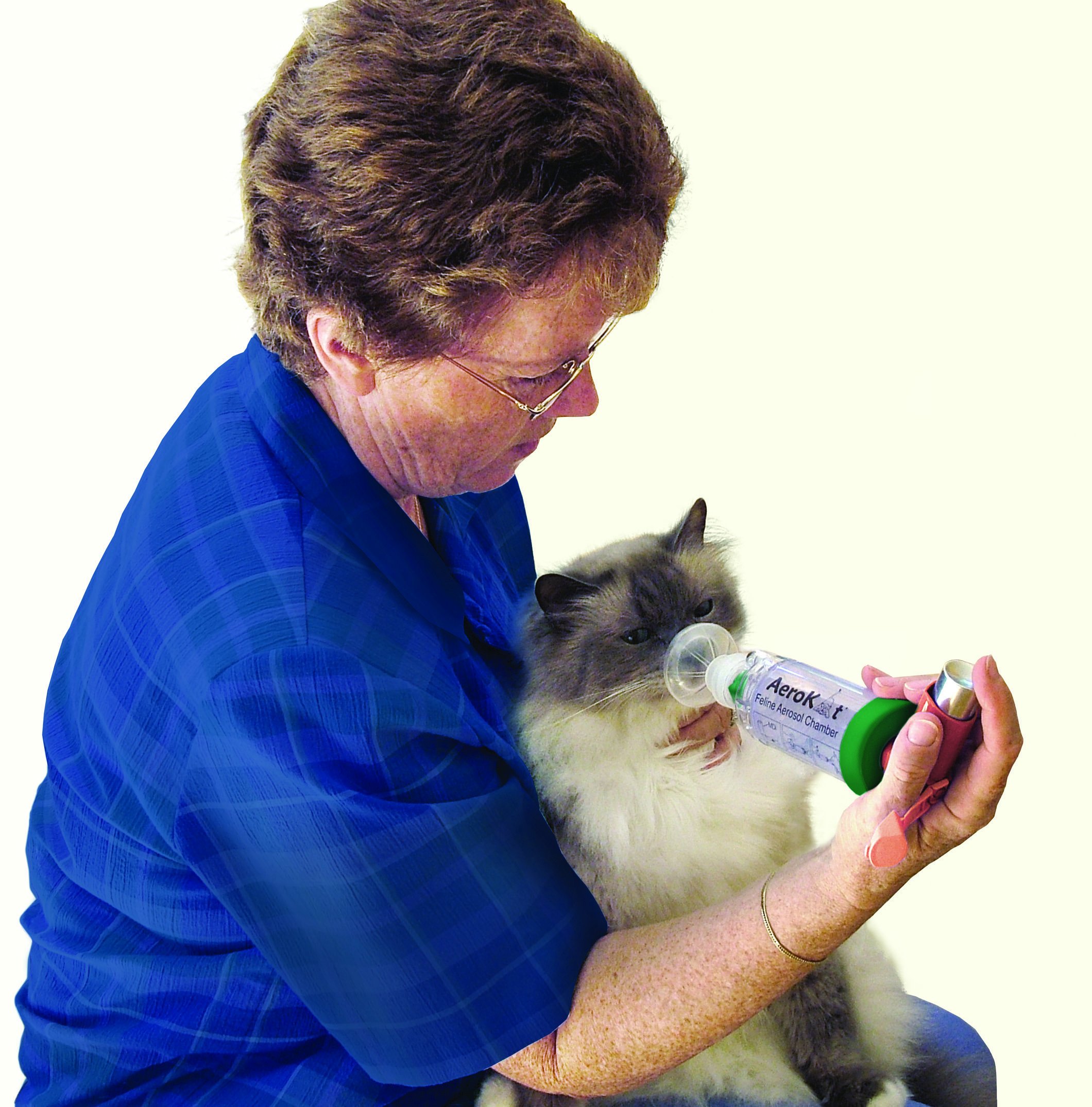According to data collected by the United States Census Bureau, well over 70 million cats are currently living in American homes. And it is estimated that 700,000 or more of them suffer from asthma, a condition marked by chronic and acute attacks of labored breathing, chest constriction, wheezing, and coughing.
According to Linda Ross, DVM, an associate professor of small animal medicine at the Cummings School, this affliction is among the most common of all feline respiratory ailments. While the disorder is incurable, she notes, it is by no means untreatable — and significant progress has been made during the past few decades toward understanding the causes of asthma and a variety of ways in which it can be treated.
Feline asthma may be described as the inflammation and mechanical constriction of a cat’s bronchioles, the slender airways that branch out from the bronchi — the two narrow tubes that lead directly from the trachea to the lungs. The narrowing of these airways occurs when a cat’s immune system overreacts to the presence of an allergy-producing substance (allergen) and responds by releasing stimulants that cause inflammation and swelling of the tissue lining the bronchioles.
Many triggers
A wide variety of airborne substances can spur an asthmatic episode, says Dr. Ross. “Pollen from trees, weeds, and grass; dust from certain types of kitty litter; household dust; and tobacco smoke are among the most common causes,” she notes. A long list of other possible allergens includes: vapors from household cleaning solutions and aerosol sprays; mold and mildew; dust mites; and smoke from fireplaces and candles. She urges owners to minimize their cats’ exposure to such potential allergens.
Thinkstock


In general, cats of all ages may be predisposed to asthma, although, Dr. Ross says, “In my experience, asthma attacks seem to start in middle-aged cats, those that are not particularly young or old. Males and females appear to be equally at risk — there is no gender predisposition.” Although it is thought by some that Siamese cats are especially vulnerable, Dr. Ross is unaware of any studies that conclusively affirm the presence of a genetic predisposition. For the time being, the role that heredity plays in susceptibility to feline asthma remains unclear.
The common signs
The signs of bronchial distress stemming from chronic asthma include frequent bouts of audible wheezing and retching — as if the affected cat is attempting to cough up a hairball. Every once in a while, an affected cat, whether playing or at rest, will abruptly begin breathing rapidly and trying to take in air with her open mouth. Her chest and abdomen will move up and down abnormally, and her breathing will be shallow and rapid; in some cases, a wheezing sound may be heard as the cat exhales.
The attacks may vary in duration, notes Dr. Ross. “Some come and go very quickly,” she says. “But they can last anywhere from a few minutes to a few days — they have no time limit.” As for their increasing severity, asthmatic attacks may be broadly classified as:
Mild: The breathing problems occur intermittently — but not daily — and do not interfere with a cat’s lifestyle
Moderate: The breathing difficulties are more pronounced and do interfere with the cat’s normal pattern of activity);
Severe: Labored breathing is more arduous, with attacks occurring daily
Life-threatening: Bronchial constriction causes potentially lethal labored breathing and severe oxygen deprivation
If the labored breathing (dyspnea) progresses, the cat’s normally pink ears, lips, nose and gums may turn blue from lack of oxygen, in which case emergency veterinary care is required. “A cat that is having severe trouble breathing and whose gums have turned blue is not getting enough oxygen into her system,” says Dr. Ross, “and she could die.”
Tricky to diagnosis
Diagnosing asthma as the cause of a cat’s acute respiratory discomfort, she points out, can be a daunting challenge, since several other conditions may be responsible for similar clinical signs. Diagnostic measures may include blood tests, X-rays, and even a fecal exam to exclude causes other than asthma for a cat’s breathing difficulties.
“Pneumonia, heartworm, lungworm, and some viral infections, for example, can also cause damage to the lungs that results in breathing difficulty,” says Dr. Ross. “Other disorders, such as heart failure, can result in fluid build-up in the chest cavity and compress the lungs. These and several other conditions are the ‘rule-outs’ for a cat that is brought into the emergency facility with fast, heavy, difficult breathing.” Based on a variety of diagnostic measures, she says, a veterinarian may be able to make a presumptive diagnosis of asthma.
The most effective drugs
Two types of drugs have emerged during recent years as the most effective agents in the treatment of feline asthma: corticosteroids, which reduce bronchial inflammation, and bronchodilators, which open up an affected cat’s airways. However, a number of drawbacks have been identified with these drugs when administered directly either in tablet form or by injection.
Frequent and extended corticosteroid therapy in cats, for example, is associated with an elevated risk for pancreatitis and diabetes. And for both corticosteroids and bronchodilators, pills and injections are inefficient, since they circulate systemically rather than targeting the specific respiratory system tissues involved in asthma.
Inhalers are now available
In this regard, a significant breakthrough was achieved with the development of inhalers, devices that deliver corticosteroid drugs such as fluticasone proprionate and bronchodilators such as albuterol on either a prescribed daily schedule or as needed. To administer the proper asthma-relieving medication, an appropriate drug is dispensed from the inhaler into a small, tube-shaped chamber called a spacer.
This device fits into a mask that is placed over an asthmatic cat’s face for as long as needed — a matter of minutes perhaps — while the owner releases the inhalant by pressing on an aerosol container connected to the other end of the spacer. The advantage of the inhaler is that a higher level of the drug goes directly to the lungs and reduces the systemic side effects that may be caused by oral and injected medications.
The first such delivery device that was developed specifically for cats and that continues to be the most widely used is a product called AeroKat™, which employs the same drug-delivery method as the metered-dose inhalers developed for humans in the 1960s. Use of an inhaler is appropriate both for treating occasional asthmatic attacks and for maintenance therapy over extended periods.


“As long as you have your veterinarian’s approval and guidance,” says Dr. Ross, “you can actually make an inhaler at home. You purchase a small, cat-sized Elizabethan collar and put it on your cat. Then cover the front of it with plastic wrap, use the spout of the inhaler to puncture a small hole in the plastic, release several puffs of the inhalant, and let the cat breathe it in for five minutes or so.”
Emergency intervention
Unfortunately, there is not much that you can do at home in the event of a prolonged asthmatic attack. “You have to get your cat to a veterinary hospital right away,” Dr. Ross advises. “The first thing the vet will do is put the cat in an oxygen cage, where the animal can rest and breathe pure oxygen for as long as needed. The veterinarian will probably treat the cat with injectable steroids — maybe a large dose — as well as drugs that will help dilate the bronchi.” — Tom Ewing





I would like to know into what position is best for a cat to take her inhaler in please.
I would like to know the best position to hold my cat in to use the inhaler she dislikes please.